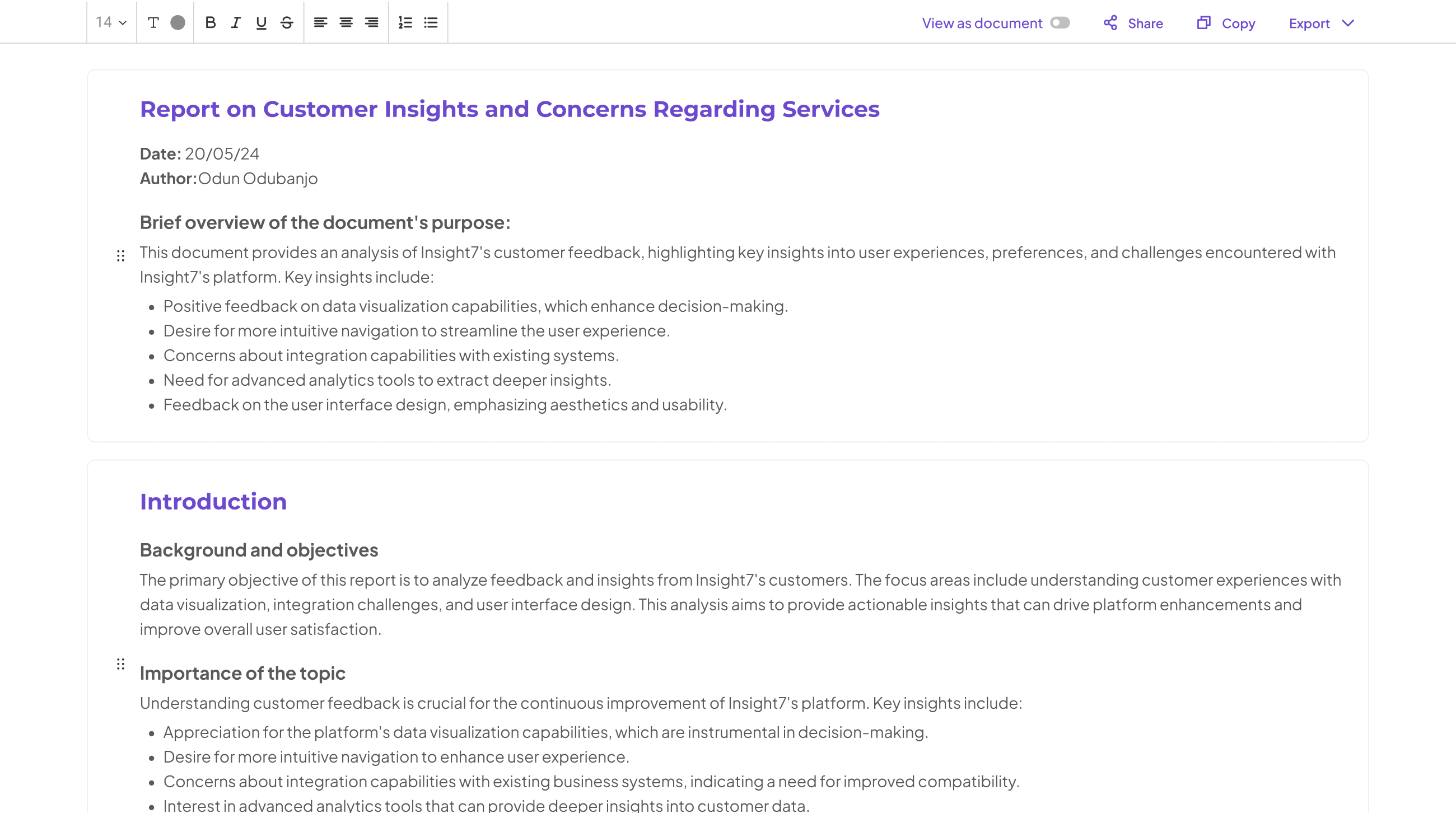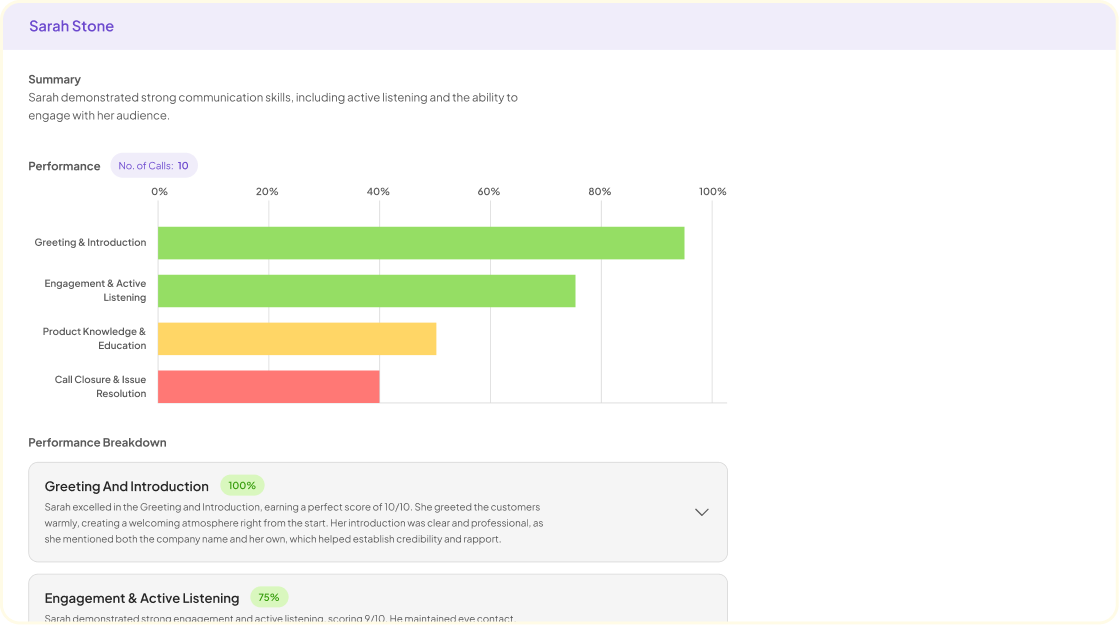In today's fast-paced world, understanding customer sentiments through interviews has transitioned from a simple dialogue to a sophisticated analytical process. AI-Powered Interview Insights offer a transformative way to visualize and decipher vast amounts of interview data effectively. The ability to dissect customer conversations not only enhances clarity but also drives actionable strategies based on real-time insights.
This approach is vital for businesses striving to stay ahead in a competitive landscape. By embracing AI-driven methods, organizations can significantly reduce the time spent on manual analysis and improve the accuracy of their interpretations. Consequently, this leads to better collaboration among teams, ensuring that critical insights are not lost in the shuffle, but instead, presented in a clear and engaging manner.
Transcribe & extract insights from interviews. At Scale.

Unveiling AI-Powered Interview Insights: The Key to Effective Prospect Analysis
Understanding AI-Powered Interview Insights is crucial for effective prospect analysis. It serves as a transformative tool, unlocking valuable knowledge from interview data. By leveraging AI technology, professionals can filter through extensive interview records, identifying key themes, pain points, and customer sentiments. This process not only streamlines reporting but also enhances the accuracy of insights derived from interviews.
The impact of AI in transforming interview analyses is significant. First, it demystifies complex data, making it accessible to anyone within an organization, regardless of technical expertise. Second, it empowers teams to visualize insights effortlessly through intuitive interfaces. This functionality allows users to engage with the data meaningfully, helping them make informed decisions that align with customer needs. As organizations adopt AI-Powered Interview Insights, they can anticipate a future of data-driven strategies that foster deeper connections with prospects.
Benefits of AI-Driven Visualization Tools
AI-Powered Interview Insights play a crucial role in transforming how we visualize and interpret prospect interview reports. One of the significant benefits of AI-driven visualization tools is their ability to reduce bias and subjectivity in interview assessments. By employing advanced algorithms, these tools ensure that data is analyzed consistently, leading to more reliable conclusions. This objectivity enhances the credibility of the insights drawn from interview data, empowering teams to make informed decisions.
Additionally, these tools enhance data-driven decision-making processes by providing intuitive visual representations of complex data sets. Users can easily identify trends and patterns that might otherwise go unnoticed. With features that allow for comprehensive queries across multiple datasets, teams can ascertain the strengths and weaknesses of their prospects more effectively. This not only streamlines the analysis but also fosters a culture of informed decision-making backed by solid evidence. Ultimately, AI-driven visualization tools unlock the full potential of AI-Powered Interview Insights, driving better outcomes for organizations.
- Reducing Bias and Subjectivity in Interview Assessments
Reducing bias and subjectivity in interview assessments is crucial for ensuring fair evaluations and making informed hiring decisions. Traditional interview processes often rely on human judgment, which can be influenced by personal biases. This can result in inconsistent assessments that overlook the true potential of candidates. By employing AI-powered interview insights, organizations can standardize evaluation criteria, leading to more objective analyses.
The systematic application of AI tools aids in extracting insights from conversation data, minimizing subjective interpretations. First, by transcribing and analyzing interviews, AI can highlight patterns in candidate responses. Next, it applies predefined benchmarks to ensure that evaluations are based on objective factors rather than personal preferences. Ultimately, this transformation not only safeguards against bias but also enhances the candidate experience, as all individuals will be evaluated under the same standards. Integrating AI-driven evaluation processes fosters a more equitable and effective recruitment framework.
- Enhancing Data-Driven Decision-Making Processes
In the realm of data-driven decision-making, AI-Powered Interview Insights serve as a transformative approach. By integrating artificial intelligence, organizations can effectively analyze and interpret insights from prospect interviews. This enhancement allows for quicker and more informed decision-making, empowering teams to act based on accurate data rather than intuition alone.
Harnessing these insights involves systematic processes that filter and summarize extensive interview data. Identifying key themes and patterns is crucial, as it enables businesses to adjust their strategies promptly. Furthermore, the use of visualization tools amplifies understanding, allowing users to see data in context. This clarity supports colleagues in discussions and promotes transparency, ultimately leading to better outcomes and more refined strategic objectives. Embracing AI-Powered Interview Insights can significantly elevate an organization's capacity to make evidence-based decisions.
Tools to Visualize AI-Powered Interview Insights
Visualizing AI-Powered Interview Insights enhances understanding and decision-making. Various tools available today allow businesses to translate interviews into actionable data. By incorporating these technologies, teams can extract significant themes, pain points, and desires directly from conversations, leading to more informed strategies.
The first key tool to consider is specialized software that organizes and analyzes transcripts efficiently. These platforms can display insights through intuitive dashboards, making patterns easy to identify. Another essential resource focuses on graphic representation, transforming qualitative data into meaningful visuals. These tools not only showcase interview results but also empower users to delve deeper into the underlying narratives.
Investing in these visualization tools streamlines the process, allowing anyone in an organization to access and interpret insights quickly. This democratization of data is crucial for fostering a culture of informed decision-making. Embracing the right tools is a significant step toward leveraging AI-Powered Interview Insights effectively.
Generate Detailed Reports from Your Qualitative Data in Minutes.
Top Tools for Visualization
Visualization tools play a crucial role in transforming interview data into actionable insights. With the right tools, businesses can effectively showcase AI-powered interview insights that illuminate patterns and trends within their prospect interviews. These tools enable users to sort through vast amounts of data, highlighting essential takeaways that might otherwise go unnoticed. By streamlining complex information, visualization becomes a powerful ally in decision-making.
One of the prominent tools available is insight7, which excels in converting qualitative data into visual formats. This leads to clearer narratives from interviews, making it easier for teams to grasp findings quickly. Tableau and Power BI also stand out, offering robust features for detailed analytics and reporting. Meanwhile, Dovetail provides an intuitive interface that focuses on qualitative data translation. Lastly, Watson Analytics harnesses AI to deliver predictive insights, enabling teams to anticipate trends based on past data. Each of these tools contributes significantly to visualizing prospect interview reports with AI efficiently and effectively.
- insight7: Leading the Charge in Interview Analysis Tools
As organizations face the ever-growing challenge of understanding customer needs, the demand for effective interview analysis tools becomes crucial. AI-Powered Interview Insights provide a solution, enabling teams to analyze and visualize data efficiently. This approach enhances their ability to make informed decisions, thereby maintaining a competitive edge. Companies often struggle with the volume of customer signals generated from interviews, which can lead to challenges in deriving actionable insights.
When utilizing modern tools for interview analysis, businesses can streamline the process considerably. AI algorithms can synthesize large amounts of qualitative data swiftly, transforming scattered insights into structured outputs. Teams can collaborate effectively, reducing the time spent on manual data processing and improving the overall quality of insights. By adopting advanced interview analysis techniques, organizations are set on a path toward more informed decision-making and strategic planning, ultimately paving the way for increased growth and success.
- Tableau: Harnessing Data Visualization for Deeper Insights
Tableau stands out as a powerful tool for visualizing AI-Powered Interview Insights, transforming complex data into insightful graphics. Through its intuitive interface, Tableau enables users to uncover patterns and trends that might go unnoticed in traditional report formats. By utilizing various visualization techniques, teams can represent positive and negative feedback from interviews, allowing for a comprehensive understanding of stakeholder perspectives.
One key benefit of Tableau is its ability to compare diverse datasets, such as interview results from different regions or time periods. This comparison fosters an environment for deeper analysis, enabling organizations to identify unique opinions and common criticisms across various demographics. Ultimately, harnessing Tableau not only streamlines the data visualization process but also enhances decision-making, making it an essential tool for organizations seeking to address feedback more effectively and improve overall performance.
- Power BI: Integrating AI for Enhanced Reporting
Integrating AI into Power BI significantly enhances the ability to visualize interview data effectively. The AI capabilities within Power BI enable users to uncover deeper insights from interview reports, allowing for a more streamlined analysis of participant responses. It simplifies the process of identifying trends, patterns, and anomalies in the data, making the reporting process more intuitive and efficient.
Utilizing AI-powered interview insights, organizations can automate data processing and reporting. This automation reduces manual effort and minimizes bias in interpreting results. Furthermore, Power BI's interactive dashboards empower users to explore data dynamically, granting them the ability to customize their reports based on specific criteria. By integrating AI within Power BI, businesses can transform raw interview data into actionable insights, leading to better decision-making and strategic planning.
- Dovetail: Translating Qualitative Data into Powerful Graphics
AI-Powered Interview Insights are crucial for translating qualitative data into impactful visuals. Dovetail emerges as a powerful tool that allows organizations to consolidate various interview materials and synthesize them into coherent graphics. This process enables teams to analyze sentiments and patterns across extensive datasets, facilitating better decision-making.
The transformation of raw data into meaningful graphics involves several steps. Initially, you collect and input all relevant interview data, which could include transcriptions and various media formats. Next, advanced AI algorithms dissect the information, pulling out key themes and insights from diverse sources. Finally, intuitive dashboards consolidate these findings, presenting them in a visual format that can easily be interpreted by stakeholders. This approach empowers teams to portray complex insights effectively, driving enhanced engagement and understanding within their organizations.
- Watson Analytics: Leveraging AI for Predictive Insights
Watson Analytics takes a transformative approach to understanding data by harnessing AI-powered interview insights. This advanced tool streamlines the process of analyzing interviews, allowing users to extract meaningful patterns from a vast array of conversations. Through its intuitive interface, team members can quickly input their interview data and generate comprehensive reports that highlight key themes and sentiments.
The platform provides various features, including automated transcript generation and sentiment analysis, helping to illuminate customer pain points and desires. This not only saves time but also significantly reduces the potential for bias in interpreting qualitative data. By visualizing this data through dynamic reports, organizations gain predictive insights that empower decision-making and strategy formulation. Ultimately, employing Watson Analytics ensures that stakeholders have access to reliable, actionable insights that drive business growth.
Implementing AI Tools: Step-by-Step Guide
To effectively implement AI tools for visualizing prospect interview reports, a systematic approach is essential. Start with Step 1: gather and input all relevant interview data into your chosen platform. Ensure that every piece of information captures the nuances of each prospect's feedback, which is crucial for accurate analysis. In Step 2, leverage AI algorithms to analyze this data, generating AI-powered interview insights that highlight trends and patterns. This step is where you will extract valuable information that could influence decision-making.
Finally, in Step 3, visualize these insights through intuitive dashboards. These visual representations not only make the data more digestible but also facilitate easier communication among stakeholders. By following these steps, you will create a comprehensive understanding of your interview data, which will empower your team to make informed, strategic choices based on robust insights gathered from prospects.
- Step 1: Gather and Input Interview Data
To effectively harness AI-Powered Interview Insights, the first step is to gather and input interview data. This process plays a crucial role in ensuring that the ensuing analysis is both accurate and meaningful. Begin by collecting all relevant data from interviews, including audio recordings, transcripts, and any supplementary documentation. Organizing this information systematically allows for a seamless transition into the analytical phase.
After gathering the necessary interview materials, it’s essential to input this data into the selected AI tool. This could involve uploading recordings and relevant evaluation criteria that will guide the AI in assessing the quality and effectiveness of the interviews. The clarity and richness of this input data directly influence the quality of insights generated. Therefore, attentiveness at this stage ensures that the AI can provide valuable, actionable insights that facilitate data-driven decision-making in your organization.
- Step 2: Analyze Data with AI Algorithms
Analyzing data with AI algorithms transforms the way organizations glean insights from prospect interview reports. The first step involves compiling the collected data from interviews, ensuring it is clean and structured for optimal processing. Once this foundational work is done, AI algorithms can be employed to uncover patterns and themes that may not be immediately obvious. These algorithms can analyze sentiments, categorize responses, and extract key insights, offering a more nuanced view of interview outcomes.
To maximize the value derived from AI-powered interview insights, several specific actions can be taken. First, utilize natural language processing (NLP) to identify recurring topics and sentiments within the interview transcripts. Next, implement clustering algorithms to group similar responses, revealing broader trends. Finally, leverage predictive analytics to forecast customer needs based on the insights gained from the interviews. By adopting these strategies, organizations can effectively leverage AI to enhance their analysis process and inform data-driven decision-making.
- Step 3: Visualize Results through Intuitive Dashboards
Visualizing results through intuitive dashboards is a pivotal step in understanding AI-powered interview insights. Engaging and user-friendly dashboards not only simplify complex data but also empower users to identify trends and patterns effectively. By presenting information visually, insights drawn from interviews become clearer, allowing teams to make informed decisions based on solid evidence.
With intuitive dashboards, stakeholders can delve into specific aspects of the data, such as positive or negative feedback, across various interview datasets. This functionality fosters a deeper exploration of customer sentiments, revealing valuable insights that can shape product development and marketing strategies. Whether comparing different locations or assessing feedback over time, these visual tools enable organizations to harness the full potential of AI-generated insights, ultimately enhancing their ability to respond to customer needs and market dynamics.
Conclusion: The Future of AI-Powered Interview Insights and Visualization
The future of AI-Powered Interview Insights holds immense potential for transforming how organizations analyze and visualize prospect interviews. By harnessing advanced algorithms, businesses can derive meaningful patterns and trends from intricate datasets. This innovation enables teams to quickly identify key pain points and themes that emerge within interviews, significantly enhancing their decision-making capabilities.
As AI continues to evolve, the visualization tools available will likely become even more sophisticated. Enhanced graphics and intuitive dashboards will allow stakeholders to digest complex information quickly. Ultimately, the adoption of AI-Powered Interview Insights will empower organizations to become more agile, informed, and effective in meeting customer needs.


